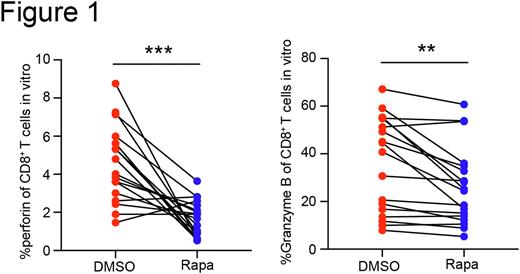Abstract
Primary immune thrombocytopenia (ITP) is an autoimmune disorder characterized with increased risk of bleeding. CD8+ cytotoxic T lymphocytes (CTLs) of ITP patients express high level of lethal molecules, leading to the lysis and apoptosis of their own platelets, which is an important mechanism of platelet destruction in ITP patients. Accumulating evidence have highlighted that the activation of mTOR signaling pathway promotes the differentiation of CD8+ T cells to CTLs, which leads to the up-regulation of cell-mediated immunity. Several studies have showed that rapamycin, a mTOR inhibitor, was effective in the treatment of relapsed/refractory ITP. However, the endogenous mechanism remains to be explored.
The activation of mTOR signaling pathway in CD8+ T cells was determined by flow cytometry. We found that the phosphorylation level of p-mTOR, p-Akt, p-4E-BP1 and p-P70S6K in ITP patients were significantly higher than that in healthy controls. Meanwhile, we found that the levels of perforin and granzyme B in CD8+ T cells in ITP patients were significantly higher than that in healthy controls.
In the in vitro experiments, CTLs were isolated from PBMCs of ITP patients or healthy controls and cultured with different concentrations of rapamycin (0-1 uM) for 3 days, and we chose an optimal concentration of 20 nM. There was no significant difference in the expression levels of mTOR, Akt, 4E-BP1, and P70S6K after rapamycin treatment, but the phosphorylation level of p-mTOR, p-Akt, p-4E-BP1, p-P70S6K was significantly inhibited by rapamycin treatment. Likewise, the ratios of p-mTOR/mTOR, p-AKT/AKT, p-4E-BP1/4E-BP1, p-P70S6K/P70S6K were also significantly down-regulated. Flow cytometry analysis found that rapamycin significantly inhibited the expression of perforin and granzyme B (Figure 1) in CD8+ T cells of ITP patients.
We further established the ITP murine model by transferring splenocytes of C57BL/6 CD61 knockout mice, immunized against platelets from wild-type syngeneic C57BL/6 mice, into severe combined immune deficient (SCID) mice. Rapamycin was injected intraperitoneally daily at a final concentration 2.0 mg/kg. Our data showed that the rapamycin group had significantly higher platelet counts compared with control group.
In summary, our findings suggest that the activation of mTOR signaling pathway-related molecules of CD8+ T cells in patients with ITP are abnormal. These data shed new light on the molecular mechanism of rapamycin action by inhibiting CTLs cytotoxicity. This novel mechanism of rapamycin underlies the potential therapeutic strategy for ITP.
Disclosures
No relevant conflicts of interest to declare.
Author notes
Asterisk with author names denotes non-ASH members.


This feature is available to Subscribers Only
Sign In or Create an Account Close Modal